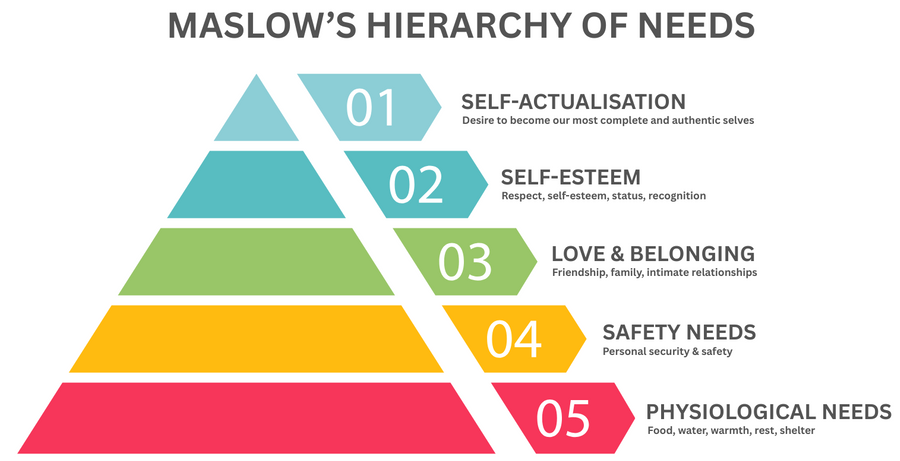The ultimate guide for new managers
Stepping into your first management role can feel both exciting and overwhelming. Whether you’ve just been promoted or you’re about to lead a team for the first time, this guide is designed to help you navigate your new responsibilities with confidence and unlock the leader within. From communicating effectively with your team to setting clear goals and celebrating success, we’ll walk you through our practical tips and strategies to help you lead with clarity and grow into the kind of manager people naturally want to follow.
Understand your employees' needs
Key to managing well, is putting your employees’ needs ahead of the KPIs, targets and goals that may be raining down on you. A high-pressure high-performing team has an inevitable timer, so take the time to set a culture within your team from the get-go. Let’s use Maslow’s hierarchy of needs to think about this. Maslow’s theory was that we need to meet someone’s basic needs (lower level) to be able to then move up and meet the next level up and so on.

But how do you, as a manager, even try to tackle this? Start small, with the basic changes you can make. For example, if your team member is struggling with their desk setup, which is causing them discomfort at work and affecting their input, then that’s an easy change you can make that will benefit your team member and the overall team’s input. There is an easier way to understand your employees’ needs, though, and that’s simply by talking to them, asking questions and showing an active interest. You might be surprised by what you learn, and how easily you can make a difference.
Manage up
Remember those needs we mentioned? Well, you have them too!
Make sure you’re taking care of yourself, and your own needs are being met, or you risk burnout or managing yourself and your team into a black hole. Your manager is there to help you, so maintain open lines of communication and tell them when things aren’t going as planned. Just as you are for your team, your manager is an advocate for their employees, so keep passing on your feedback and observations to upper management, because you may be struggling with things that are a challenge across the company that you just don’t know about. By vocalising this, you’re providing constructive feedback that could be vital to informing wider strategic decisions, policies and initiatives that come around to benefit you and your employees.
Learn how to coach your team
The best leaders don’t just bark orders; they cultivate a culture of growth and development from day one. The modern workforce has seen a shift and gone are the days when employees wanted to be told what to do and get on with it. Of course, everyone has different working styles and needs, but again, that’s why you need to adopt the ‘coach’ approach.
Listen to what your employees are saying, encourage open communication, and really get to know them individually. Each team member will have different strengths and weaknesses, different career goals and different drivers that motivate them. Ask them what they’d like to improve or what they struggle with and offer them coaching in the form of solutions, training or perhaps additional support.
If you spot the next coding genius in your team, who is passionate about streamlining websites and user journeys, give them relevant opportunities to challenge and develop themselves. If an employee has never written a project brief before but they’re simply lacking the confidence, sit down with them and show them how you do it, and ask them to do the next one.
"Management is about persuading people to do things they do not want to do, while leadership is about inspiring people to do things they never thought they could.” - Steve Jobs
Coaching your team, simply put, is providing support where it’s needed and providing opportunities to help them develop and grow. They may thank you for giving them a push they never thought they needed, and they can now do something they thought they would never be good at.
Set up 121 meetings
We all know when things get busy, 121s can be left at the wayside, but these regular catchups are so important. Set up 121 meetings with your employees and put your coaching into action. The role of a manager covers everything from goal setting to measuring performance to checking in on your employees’ general well-being.
Create a safe space where your employees know they can speak freely and make it clear to them that you’re here to advocate for them. It can be all too easy to never talk about work struggles or ill health, but the truth is, both can have a detrimental effect on your employee and, therefore, the team output.
Take the time to ask questions and provide feedback in these catch-up sessions and encourage your employees to bring their feedback and ideas to the table without judgement, so they feel comfortable, seen, and heard.
Learn how to give constructive feedback
Nobody likes to be the bearer of bad news, but it’s time to stop thinking about it as bad news. Constructive feedback is not necessarily telling someone they’re unequivocally wrong; it’s about saying what they did well, but what they could do even better, or informing them of processes if that’s where a mistake has been made. Once again, communication is key. Ask your employee how they are, how they found a project, and what they struggled with. Context will help you plan your next steps easily.
If your employee tried to write a blog post and it came across a little pretentious and not particularly inclusive, try and find what they did well, or ask them about their intentions and have an informal conversation. Then suggest to them approaching blog-writing another way. If your tone of voice is difficult to put into words, put it into visuals or an idea you can explain better. For example, maybe you could tell them they absolutely understood the task and topic at hand, but in the next post, they could try writing as if they’re speaking to their friend’s mum, or their grandma (whatever’s relevant).
Encourage feedback from your team

There are two parts to this advice. As a new manager, you might not have been in the position of encouraging feedback from team members before. This is key if you want to truly cultivate a culture of openness and honesty and create a safe environment where all your employees feel they can speak and be heard, without judgement.
Most important, though, is to learn to graciously accept feedback. You’re only human, and you will get things wrong. If your team members can tell you when something has made them feel upset or that a particular process could be streamlined by making some adjustments, then actively listen to them and show an interest in what they’re bringing to the table. You might become aware of gaps you hadn’t even thought about or even learn things that allow you to grow as an individual.
Practice your creative problem-solving
Improving your creative problem-solving will improve both your impact and output as a manager and broadly help your employees feel safe and supported at work. Plans don’t always stay on track, and sometimes an angry customer or a glitch in the system can completely derail things. When these things happen, take a moment to think about what is possible, rather than all the things this one occurrence could potentially cause to happen.
"Lead by example with hope, never fear.” - Michelle Obama
When you start problem-solving creatively, you start thinking clearly in times of stress or pressure. This skill in a leader will help your employees turn to you in times of crisis, and strengthen trust, because they know their manager will come up with creative solutions that can save the day. Practice makes perfect with this one, and it’s not a skill people are born with; you can develop it over time.
Your coaching will come in handy here, too. Take what you’ve learned and the knowledge of your employees’ strengths and use them! Bring the team together and tell each of them what you need from them. You’ll start to create a team that can work collaboratively where each team member feels valued and like an integral part of what you’re doing.
Ask the right questions and practice active listening
As we’ve said throughout this guide, a good manager will ask questions and listen well. Active listening doesn’t just mean listening to your employee, saying you’ll pass their feedback on, and leaving it there. Be honest with your employee; they’ll appreciate it in the long run. If you’re going to pass it on, let them know to whom and how, and be sure to come back to them and update them, or they’ll start to feel unheard, forgotten and invisible.
Ask the right questions so you can make the right decisions, for the business and the individual. By asking the right questions, you can gather context and bring clarity to the decisions that might need to be made in a way where the individual remains central. Always seek context, whether it’s to shed light on a drop in performance, or a sudden change in behaviour, or even a shift in the language your employee is using.
You never know what is going on in your employees’ heads, and if you take the time to listen, then you’ll strengthen your relationship, and more often than not, be able to help in some way, big or small.
Build a team strategy
We’ve touched on building a team that can work collaboratively, and team strategy is a key part of this. Create a plan that defines responsibilities, provides direction and establishes a clear framework for your employees. Include how the team will work together to achieve specific goals, how each individual will contribute, and bring it all together with a shared vision and overarching objectives.
As a manager, your team will look to you for direction and purpose at work, so make sure you’re being really clear about what you want and need from them, and that everyone is aligned with the end vision in mind. Once again, utilise the strengths of each employee, so they can feel important and feel their contributions are valued and necessary.
"Coming together is a beginning. Keeping together is progress. Working together is success." - Henry Ford
Share strategy with your team
Always ensure you’re sharing your strategy as well as wider organisational strategy with your team, so they know what every task they are working on is contributing to. Too often, employees can feel ‘what I do isn’t important, so I’m not going to bother’, and it’s simply because they don’t have any sight of the big picture strategy and, more importantly, where they fit in.
Share the strategies with your employees, break them down, and show them where they fit in and why their contributions matter. This also means that in a landscape of constant change management across sectors, you can effectively help your employees understand management decisions as and when they arise and make those moments easier to manage as a manager, and easier for employees to navigate with ongoing context.
Set SMART team goals
Alongside sharing strategy and wider goals, you need to make sure you’re setting goals within your team, to make the big picture relevant to your team and employees’ contributions. Make the goals SMART (see below) so you can focus efforts, track progress, highlight anything that needs addressing, and ultimately lead your team to success. These will keep your team on task and allow you to use your coaching skills to manage well.

Regularly share praise and recognition
Following on from providing regular feedback and coaching your employees, be sure to praise them, and praise them publicly. Every employee wants to be seen and feel valued, especially if their contributions go above and beyond, or make a difference to what you’re creating, whether big or small. Let them know when they’re doing well and on track, so they are motivated to keep doing what they’re doing, and often they’ll continue to surprise you in amazing ways.
Commit to personal development
Create a space where your employees know you’re there to support their goals and personal development and then commit to it. The worst thing you can do is make them feel like you’re there to help them and then not keep your word. It’s another step to feeling undervalued and invisible. Invite your employees to bring any opportunities they want to pursue to you and remember to pass on relevant opportunities to them. This doesn’t just apply to your team members, though; put your personal development at the top of your goals, read and actively seek information so you can constantly improve your practice as the best manager you can be.
At The Institute of Leadership, many organisations work with us to provide personal and professional development opportunities to their employees, from exclusive event access to tools, insights and resources to make upskilling easy. With a range of memberships and a dedicated corporate offering, there’s an option to suit all organisations and budgets.
Ready to grow as a leader? Discover how IoL Membership can support your journey.

